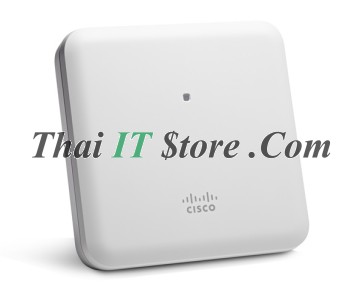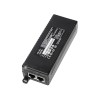- หน้าหลัก
- Wireless (แอ็กเซสพอยต์)
- Cisco Aironet 1852 | AIR-AP1852I-S-K9 Aironet 1852i Lightweight AP Internal Antennas


มีบริการอุปกรณ์สำรองระหว่างซ่อมและ Onsite Services ตลอด 24 ชั่วโมง 365 วัน (ข้อมูลเพิ่มเติม คลิก...)
Cisco Aironet 1852 | AIR-AP1852I-S-K9 Aironet 1852i Lightweight AP Internal Antennas
| Band: | Cisco |
| Type: | Wireless Access Point |
| Model: | Aironet 1852 |
| Part Number: | AIR-AP1852I-S-K9 |
| Features: | Lightweight AP |
| Detail: | AIR-AP1852I-S-K9 | Aironet 1852i Lightweight AP Internal Antennas |
เลือกสินค้าที่ต้องการหยิบใส่รถเข็น หรือ เลือกทั้งหมด
บทความที่เกี่ยวข้อง
- Cisco MA แบบ SMB Support (CON-SMBS) คืออะไร
- Engineer Services
- Pre-Sale Services
- ตั้งค่า COM port เพื่อ Config Cisco
- เครื่องคอมใช้ COM port อะไรตั้งค่า Cisco
- ตั้งค่า Cisco Console (Serial port) สำหรับ Config ด้วย Putty
- วิธี Download Cisco Firmware, IOS
- ติดตั้ง และตั้งค่า TFTP Server สำหรับ Cisco
- สถานะไฟ LED Cisco Aironet 1852
- การรับประกัน
- การจัดส่ง
- การชำระเงิน
- Cisco Mobility Express
- Cisco Aironet ขึ้นไฟสีแดงแก้ไขอย่างไร
- ขั้นตอนขอเปลี่ยนอุปกรณ์ เพื่อทดแทนอุปกรณ์ที่เสีย (Hardware Replacement)
- ขั้นตอนการสมัคร CCO id
- Cisco SMARTnet vs SMBS
- Cisco DOA Warranty 90 วัน คืออะไร
Product overview
Ideal for small and medium-sized networks, the Cisco® Aironet® 1850 Series delivers industry-leading performance for enterprise and service provider markets via enterprise-class 4x4 MIMO, four-spatial-stream access points that support the IEEE’s new 802.11ac Wave 2 specification. The Aironet 1850 Series extends support to a new generation of Wi-Fi clients, such as smartphones, tablets, and high-performance laptops that have integrated 802.11ac Wave 1 or Wave 2 support.
Features and benefits
With 802.11ac Wave 2, the Aironet 1850 Series provides a data rate of up to 1.7 Gbps on the 5-GHz radio, more than triple the rates offered by today’s high-end 802.11n access points. It also enables a total aggregate dual-radio data rate of 2.0 Gbps, providing the necessary foundation for enterprise and service provider networks to stay ahead of the performance and bandwidth expectations and needs of their wireless users.
Due to its convenience, wireless access is increasingly the preferred form of network connectivity for corporate users. Along with this shift, there is an expectation that wireless should not slow down users’ day-to-day work, but should enable a high-performance experience while allowing users to move freely. The 1850 Series delivers industry-leading performance for highly secure and reliable wireless connections and provides a robust mobility experience that includes:
● 802.11ac Wave 2 with 4x4 Multiple-Input Multiple-Output (MIMO) technology with four spatial streams when operating in single-user MIMO mode and three spatial streams while operating in multiuser MIMO mode, offering 1.7-Gbps rates for more capacity and reliability than competing access points.
● Multiuser MIMO, allowing transmission of data to multiple 802.11ac Wave 2 capable clients simultaneously to improve client experience. Prior to multiuser MIMO, 802.11n and 802.11ac Wave 1 access points could transmit data to only one client at a time, typically referred to as single-user MIMO.
● Transmit beamforming technology to improve downlink performance to mobile devices, including one-, two-, and three-spatial-stream devices on 802.11ac, while improving battery life on mobile devices such as smartphones and tablets.
● Flexible deployment mode through the Cisco Mobility Express Solution is ideal for small to medium-sized deployments that require multiple access points. Easy setup allows the 1850 Series to be deployed on networks without a physical controller.
All of these features help ensures the best possible end-user experience on the wireless network. Cisco also offers the industry’s broadest selection of 802.11n and 802.11ac antennas, delivering optimal coverage for a variety of deployment scenarios.
Product specifications
|
Feature |
Specifications |
||||
|
Software |
Cisco Unified Wireless Network Software Release with AireOS wireless controllers: ● 8.2.100.0 or later for the Cisco Aironet 1850 Series Access Points
|
||||
|
Deployment modes |
Centralized local, Standalone*, Sniffer, Cisco FlexConnect™, Monitor, OfficeExtend, Mesh** |
||||
|
Supported wireless LAN controllers |
● Cisco 3500 Series Wireless Controllers, Cisco 3500 Series Wireless Controllers, Cisco Wireless Controller Module for ISR G2, Cisco Wireless Services Module 2 (WiSM2) for Catalyst® 6500 Series Switches, Cisco 5500 Series Wireless Controllers, Cisco Flex® 7500 Series Wireless Controllers, Cisco 8500 Series Wireless Controllers, Cisco 5760 Series Wireless Controllers**, Cisco Catalyst 3650 / 3850 Series switch with integrated controller**
● Cisco Mobility Express
|
||||
|
802.11n version 2.0 (and related) capabilities |
● 4x4 MIMO with four spatial streams
● Maximal Ratio Combining (MRC)
● 20- and 40-MHz channels
● PHY data rates up to 600 Mbps (40 MHz with 5 GHz)
● Packet aggregation: A-MPDU (Tx/Rx), A-MSDU (Tx/Rx)
● 802.11 Dynamic Frequency Selection (DFS)
● Cyclic Shift Diversity (CSD) support
|
||||
|
802.11ac Wave 1 and 2 capabilities |
● 4x4 MIMO with four spatial streams, single-user MIMO
● 4x4 MIMO with three spatial streams, multiuser MIMO
● MRC
● 802.11ac beamforming (transmit beamforming)
● 20-, 40-, and 80-MHz channels
● PHY data rates up to 1.7 Gbps (80 MHz in 5 GHz)
● Packet aggregation: A-MPDU (Tx/Rx), A-MSDU (Tx/Rx)
● 802.11 DFS
● CSD support
● Rogue device detection
|
||||
|
Feature |
Specifications |
||||||||||||||
|
Maximum number of nonoverlapping channels |
2.4 GHz ● 802.11b/g:
◦ 20 MHz: 3
● 802.11n:
◦ 20 MHz: 3
|
5 GHz ● 802.11a:
◦ 20 MHz: 25
● 802.11n:
◦ 20 MHz: 25
◦ 40 MHz: 12
● 802.11ac:
◦ 20 MHz: 21
◦ 40 MHz: 12
◦ 80 MHz: 6
|
|||||||||||||
|
Maximum transmit power |
2.4 GHz ● 802.11b
◦ 22 dBm, 3 antennas
● 802.11g
◦ 22 dBm, 3 antennas
● 802.11n (HT20)
◦ 22 dBm, 3 antennas
|
5 GHz ● 802.11a
◦ 23 dBm, 4 antennas
● 802.11n (HT20)
◦ 23 dBm, 4 antennas
● 802.11n (HT40)
◦ 23 dBm, 4 antennas
● 802.11ac
◦ non-HT80: 23 dBm, 4 antennas
◦ VHT20: 23 dBm, 4 antennas
◦ VHT40: 23 dBm, 4 antennas
◦ VHT80: 23 dBm, 4 antennas
|
|||||||||||||
|
Note: The maximum power setting will vary by channel and according to individual country regulations. Refer to the product documentation for specific details. |
|||||||||||||||
|
Available transmit power settings |
2.4 GHz ● 22 dBm
● 19 dBm
● 16 dBm
● 13 dBm
● 10 dBm
● 7 dBm
● 4 dBm
● 1 dBm
|
5 GHz ● 23 dBm
● 20 dBm
● 17 dBm
● 14 dBm
● 11 dBm
● 8 dBm
● 5 dBm
● 2 dBm
|
|||||||||||||
|
Note: The maximum power setting will vary by channel and according to individual country regulations. Refer to the product documentation for specific details. |
|||||||||||||||
|
Integrated antenna |
● 2.4 GHz, gain 3 dBi, internal omni, horizontal beamwidth 360°
● 5 GHz, gain 5 dBi, internal omni, horizontal beamwidth 360°
|
||||||||||||||
|
External antenna (sold separately) |
● Certified for use with antenna gains up to 6 dBi (2.4 GHz and 5 GHz)
● Cisco offers the industry's broadest selection of antennas, delivering optimal coverage for a variety of deployment scenarios
|
||||||||||||||
|
Interfaces |
● 1 x 10/100/1000BASE-T autosensing (RJ-45), Power over Ethernet (PoE)
● 1 x 10/100/1000BASE-T autosensing (RJ-45), AUX (used for Link Aggregation)
● Management console port (RJ-45)
● USB 2.0 (enabled via future software)
|
||||||||||||||
|
Indicators |
● Status LED indicates boot loader status, association status, operating status, boot loader warnings, boot loader errors
|
||||||||||||||
|
Dimensions (W x L x H) |
● Access point (without mounting bracket): 8.3 x 8.3 x 2 in. (210.8 x 210.8 x 50.8 mm)
|
||||||||||||||
|
Weight |
● 3.12 lb (1.41 kg)
|
||||||||||||||
|
Environmental |
Cisco Aironet 1850i ● Nonoperating (storage) temperature: -22° to 158°F (-30° to 70°C)
● Nonoperating (storage) altitude test: 25˚C, 15,000 ft.
● Operating temperature: 32° to 122°F (0° to 50°C)
● Operating humidity: 10% to 90% (noncondensing)
● Operating altitude test: 40˚C, 9843 ft.
Cisco Aironet 1850e ● Nonoperating (storage) temperature: -22° to 158°F (-30° to 70°C)
● Nonoperating (storage) altitude test: 25˚C, 15,000 ft.
● Operating temperature: -4° to 122°F (-20° to 50°C)
● Operating humidity: 10% to 90% (noncondensing)
● Operating altitude test: 40˚C, 9843 ft.
|
||||||||||||||
|
System memory |
● 1 GB DRAM
● 256 MB flash
|
||||||||||||||
|
Input power requirements |
● AP1850: 44 to 57 VDC
● Power supply and power injector: 100 to 240 VAC; 50 to 60 Hz
|
||||||||||||||
|
Power draw |
● 20.9W
Note: When deployed using a Power over Ethernet (PoE) specification, the power drawn from the power sourcing equipment will be higher by some amount, depending on the length of the interconnecting cable. |
||||||||||||||
|
Powering options |
● 802.3at
● Enhanced PoE
● Cisco power injector, AIR-PWRINJ6=
● Cisco local power supply, AIR-PWR-D=
● Cisco power injector, AIR-PWRINJ5= (Note: this injector supports 802.3af only)
● 802.3af
Note: If 802.3af PoE is the source of power, (1) the 1852e 2.4-GHz radio will shift to 2x3 from 3x4, (2) The USB port and AUX Ethernet port are disabled on both the 1852i and 1852e. |
||||||||||||||
|
Warranty |
Limited lifetime hardware warranty |
||||||||||||||
|
Compliance standards |
◦ UL 60950-1
◦ CAN/CSA-C22.2 No. 60950-1
◦ UL 2043
◦ IEC 60950-1
◦ EN 60950-1
● Radio approvals:
◦ FCC Part 15.247, 15.407 *
◦ RSS-210 (Canada)
◦ EN 300.328, EN 301.893 (Europe)
◦ ARIB-STD 66 (Japan)
◦ ARIB-STD T71 (Japan)
◦ EMI and susceptibility (Class B)
◦ FCC Part 15.107 and 15.109 *
◦ ICES-003 (Canada)
◦ VCCI (Japan)
◦ EN 301.489-1 and -17 (Europe)
◦ EN 60601-1-2 EMC requirements for the Medical Directive 93/42/EEC
● IEEE standards:
◦ IEEE 802.11a/b/g, 802.11n, 802.11h, 802.11d
◦ IEEE 802.11ac Draft 5
● Security:
◦ 802.11i, Wi-Fi Protected Access 2 (WPA2), WPA
◦ 802.1X
◦ Advanced Encryption Standard (AES)
● Extensible Authentication Protocol (EAP) types:
◦ EAP-Transport Layer Security (TLS)
◦ EAP-Tunneled TLS (TTLS) or Microsoft Challenge Handshake Authentication Protocol Version 2 (MSCHAPv2)
◦ Protected EAP (PEAP) v0 or EAP-MSCHAPv2
◦ EAP-Flexible Authentication via Secure Tunneling (FAST)
◦ PEAP v1 or EAP-Generic Token Card (GTC)
◦ EAP-Subscriber Identity Module (SIM)
● Multimedia:
◦ Wi-Fi Multimedia (WMM)
● Other:
◦ FCC Bulletin OET-65C
◦ RSS-102
|
||||||||||||||
| ประเภท | Wireless Access Point |
|---|---|
| Model | Aironet 1852 |
| License / Features | Lightweight AP |






